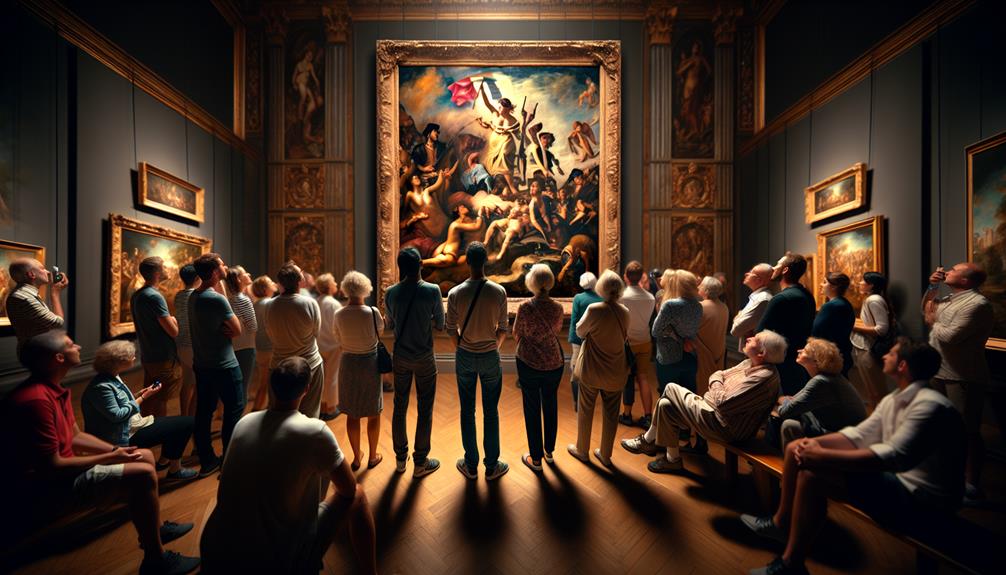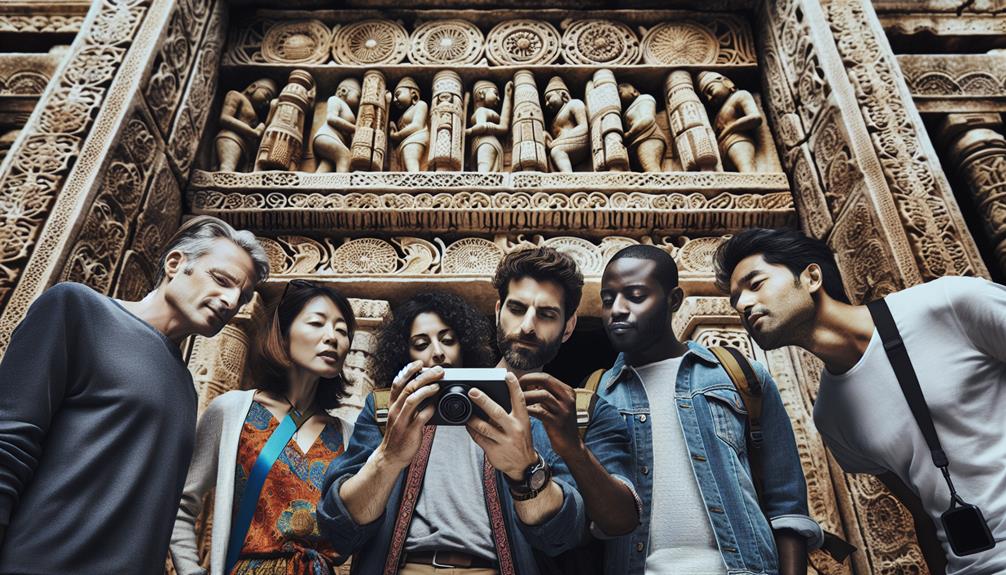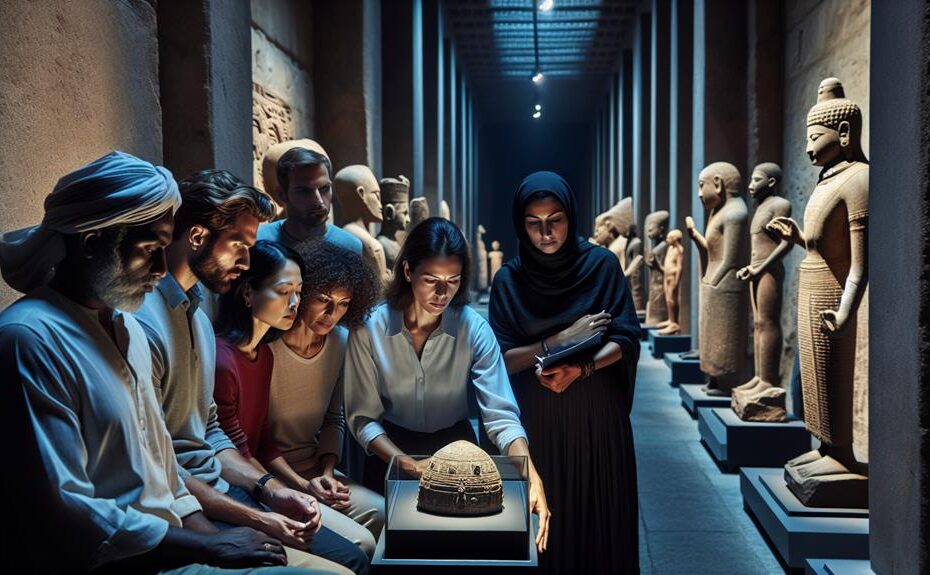As you stroll through the corridors of ancient ruins and gaze upon centuries-old paintings, a serendipitous encounter with art and history awaits. Each step you take unravels stories of bygone eras, offering glimpses into the minds of artists who shaped the past. But what if these tours could do more than just provide a window into history? What if they could also serve as a conduit for personal growth and introspection, allowing you to connect with the past in ways you never imagined?
Key Takeaways
- Explore hidden historical gems for deeper insights into overlooked narratives.
- Connect past and present narratives through art, revealing cultural evolution.
- Reflect on cultural significance through art, symbols, and societal values.
- Engage with local artisans in hands-on workshops for cultural immersion.
- Immerse in museums with interactive exhibits for a mindful exploration of history.
The Power of Art Appreciation

Art appreciation holds the ability to transport you through time, allowing for a deeper understanding of cultural contexts and historical significance. When engaging with art, whether through mindfulness practice or art therapy, you open yourself to a world of creative expression and self-reflection. Through the lens of art, you can explore emotions, thoughts, and experiences in a way that transcends verbal communication. Art serves as a mirror, reflecting your innermost feelings and sparking introspection.
In the realm of mindfulness practice, art appreciation can be a powerful tool for grounding oneself in the present moment. By immersing yourself in the details of a painting or sculpture, you cultivate a state of awareness that fosters a sense of calm and clarity. Similarly, in art therapy, creative expression through various mediums allows for the externalization of internal conflicts and emotions, leading to a deeper understanding of oneself.
In essence, art appreciation goes beyond mere observation; it’s a transformative journey of self-discovery and enlightenment.
Uncovering Hidden Historical Gems
Exploring lesser-known historical sites can offer a rich tapestry of insights into the past, shedding light on intriguing narratives often overlooked in mainstream discourse. Hidden treasures and forgotten monuments are waiting to be discovered, holding within them the untold stories of bygone eras. Unearthing secrets and lost artifacts in these off-the-beaten-path locations can provide a deeper understanding of historical events and cultural evolution.
These hidden historical gems are like puzzle pieces that, when put together, reveal a more comprehensive picture of our collective history. They offer a unique perspective, showcasing aspects of the past that may challenge conventional narratives or bring to light forgotten contributions of individuals and communities.
Visiting these sites allows you to immerse yourself in a world where time seems to stand still, offering a glimpse into the lives of those who came before us. By exploring these hidden historical gems, you not only enrich your own understanding but also contribute to preserving these valuable pieces of our shared heritage for future generations to appreciate.
Mindful Observations of Masterpieces
C:\Users\Administrator\Desktop\ZimmWriter\zimmwriter_v10.259\zimmwriter\output\Art_and_History_Tours_for_Mindful_Exploration_0002.jpg

Engaging with renowned works of art necessitates a focused and contemplative approach, allowing you to uncover layers of meaning and intention woven into each masterpiece.
To truly appreciate a masterpiece, practice mindful observation. Start by observing the piece as a whole – take note of its size, color palette, and overall composition. Then, delve deeper into the details. Notice the brushstrokes, the intricate textures, and any hidden symbols or motifs. This careful observation can reveal the artist’s skill and intention, providing insights into the historical context or personal influences that shaped the artwork.
Mindful observation can also spark artistic inspiration. As you immerse yourself in a masterpiece, pay attention to how it makes you feel. Does it evoke certain emotions or memories? Consider how the artist achieved this effect through their choice of colors, subject matter, or technique.
Connecting Past and Present Narratives
Delving into the historical contexts and intertwining narratives of artworks can offer profound insights into the connections between past and present realities. By exploring the present-day relevance of ancient influences and the contemporary connections to past inspirations, you can uncover a rich tapestry of cultural evolution. This journey through time allows you to witness how art has been a mirror reflecting society across centuries, shaping and being shaped by the world around it.
In the table below, we illustrate the interplay between past and present narratives through select artworks:
| Artwork | Historical Context |
|---|---|
| The Birth of Venus | Represents ancient mythological figures in a modern light |
| Guernica | Reflects the horrors of war in a contemporary setting |
| Mona Lisa | Blends Renaissance aesthetics with modern admiration |
These examples showcase how artists draw from historical themes to create pieces that resonate with current audiences, bridging the gap between bygone eras and today’s world.
Reflecting on Cultural Significance

As you explore the art and history tours, you’ll uncover cultural symbols that hold deep significance in the narrative of a society.
By gaining historical contextual insights, you’ll be able to appreciate the layers of meaning embedded within these symbols.
Through exploring artistic interpretations, you can further understand how these cultural elements have shaped the identity of a community.
Cultural Symbols Unveiled
Exploring cultural symbols reveals intricate layers of meaning and historical significance embedded within artistic expressions. Symbols serve as gateways to understanding the values, beliefs, and traditions of a particular culture. Through symbolic interpretations, you delve into a world where colors, shapes, and patterns communicate narratives that have withstood the test of time.
Each cultural symbol is like a thread woven into the tapestry of history, carrying stories of triumph, struggle, and resilience.
When engaging in cultural exploration, pay attention to the details. For example, the lotus flower in Eastern cultures symbolizes purity and enlightenment, while the eagle in Native American traditions represents strength and vision. By deciphering these symbols, you not only gain insight into the artistic creations themselves but also into the people who crafted them.
Cultural symbols are bridges connecting the past with the present, offering a profound glimpse into the collective consciousness of a society. As you unravel the meanings behind these symbols, you embark on a journey of discovery, empathy, and appreciation for diverse cultural identities.
Historical Contextual Insights
Uncovering the historical context behind artistic creations provides invaluable insights into the cultural significance embedded within them. When delving into the historical significance of artworks, you gain a deeper understanding of the forces that shaped them and the messages they convey.
Exploring the artistic influences that guided the creation of these pieces allows you to appreciate the interconnectedness of different artistic movements and periods. Here are some key aspects to consider:
- Evolution of Styles: Understanding how artistic styles evolved over time can shed light on the cultural shifts that influenced artists.
- Political Climate: Historical context often reveals how political events and ideologies impacted the creation of art, reflecting societal values and tensions.
- Technological Advancements: Examining the technological advancements available during a specific period can explain the innovative techniques used by artists.
- Cross-Cultural Exchanges: Recognizing the influence of different cultures on artistic developments can lead to rich interpretations of artworks with diverse origins.
Artistic Interpretations Explored
Delving into the cultural significance of artistic interpretations provides a profound understanding of the intertwined relationships between art and society. Artistic interpretations serve as mirrors reflecting the beliefs, values, and struggles of a particular time and place. By engaging in mindfulness practices during your exploration of these interpretations, you can deepen your connection to the emotions and messages conveyed by the artists.
Artistic interpretations often encapsulate societal norms, political unrest, or cultural movements, offering viewers a window into the past. Through mindfulness practices, you can fully immerse yourself in the artwork, allowing for a richer interpretation of its significance. Pay attention to the details, colors, and symbols used by the artist; these elements often carry layers of meaning that can be uncovered through mindful observation.
Engaging With Local Artisans
Interacting with local artisans during art and history tours can provide you with a deeper understanding of the cultural significance behind the craftsmanship you witness. These interactions offer a unique opportunity to delve into the rich tapestry of local craftsmanship and traditional techniques. Here are some ways engaging with local artisans can enhance your experience:
- Hands-On Workshops: Participate in hands-on workshops where artisans teach you traditional techniques, allowing you to create your own piece of art.
- Personal Stories: Listen to the personal stories of artisans, gaining insight into their lives, inspirations, and the historical context of their work.
- Custom Creations: Explore the possibility of commissioning a custom piece from a local artisan, tailored to your preferences and reflecting the local cultural heritage.
- Cultural Exchange: Engage in meaningful conversations with artisans, exchanging knowledge about art, history, and culture, fostering a deeper connection with the local community.
Meditative Walks Through History

Exploring historical sites through meditative walks offers a contemplative journey into the past, allowing you to immerse yourself in the stories and ambiance of bygone eras. These walks provide a unique opportunity for peaceful reflection and historical mindfulness.
As you stroll through ancient streets or wander around historic landmarks, the gentle pace of the walk encourages you to notice details that may have been overlooked in a hurried visit. The rhythmic sound of your steps on cobblestones or dirt paths can create a meditative atmosphere, fostering a deeper connection with the historical significance of the surroundings.
Meditative walks through history not only engage your senses but also stimulate your mind as you ponder the lives of those who once inhabited these spaces. The quietude of these walks allows for introspection, offering a chance to appreciate the beauty and complexity of the past.
Immersive Experiences in Museums
Immerse yourself in the world of art and history through interactive museum exhibits that bring the past to life.
Guided art walks offer a unique opportunity to engage with the artwork and gain a deeper understanding of the artist’s vision.
These immersive experiences in museums provide a hands-on approach to learning and appreciation of cultural heritage.
Interactive Museum Exhibits
Enhancing the traditional museum experience, interactive exhibits offer visitors a dynamic and engaging way to delve into history and art. Through the integration of interactive technology and tactile learning, museums are revolutionizing how visitors interact with exhibitions.
- Virtual Reality Experiences: Step into the past through virtual reality simulations that transport you to historical events or art movements.
- Touchscreen Displays: Engage with artifacts and artworks through touchscreen displays that provide in-depth information and interactive features.
- Augmented Reality Guides: Use augmented reality apps to uncover hidden details or stories behind exhibits by pointing your device at specific objects.
- Interactive Art Installations: Create your own art piece within the museum space, blurring the lines between observer and creator.
These interactive elements not only cater to a variety of learning styles but also foster a deeper connection to the subject matter. By actively participating in the museum experience, visitors can gain a richer understanding of history and art in a way that’s both educational and enjoyable.
Guided Art Walks
Guided Art Walks offer museum visitors a curated and immersive journey through the intricate tapestry of artistic masterpieces, providing a unique insight into the context and significance of each work. As you embark on these walks, you’ll engage in interactive discussions with knowledgeable guides who unravel the stories behind the artworks, enriching your understanding of the pieces on display.
The experience extends beyond the confines of indoor galleries, often incorporating outdoor exploration to create a dynamic and multifaceted encounter with art.
Through art interpretation sessions during these walks, you’ll delve deeper into the nuances of various art forms, learning about techniques, symbolism, and historical perspectives that shape the creations before you. Group reflections foster a collaborative atmosphere, allowing for diverse viewpoints and shared discoveries among participants.
This communal approach not only enhances your appreciation for art but also encourages a deeper connection with the cultural heritage preserved within museum walls. So, embrace the opportunity to join a Guided Art Walk and immerse yourself in a transformative exploration of artistic expression.
Frequently Asked Questions
Are Meals and Accommodations Included in the Tour Package?
Yes, meals and accommodations are typically included in the tour package. You can customize your tour to fit dietary restrictions and choose from various accommodation options. Group discounts may be available for larger parties.
Is Transportation Provided Between Locations on the Tour?
Need a stress-free journey to each stop? Does the tour cover transportation between locations? Enjoy seamless travel logistics with shuttle services provided for your convenience. Sit back, relax, and immerse yourself in mindful exploration.
Are There Any Age Restrictions for Participating in the Tours?
You must be at least 18 years old to participate in the tours. Age eligibility ensures a mature understanding of the content. The group dynamics rely on this limitation to foster an environment conducive to meaningful exploration and learning.
Can I Purchase Art or Souvenirs During the Tour?
Like a treasure chest waiting to be opened, the tours offer shopping options for art purchases and a variety of cultural memorabilia. You can browse and select souvenirs to remember your mindful exploration journey.
Are There Opportunities for Hands-On Art Experiences During the Tour?
Yes, you can engage in hands-on art experiences during the tour. Art workshops provide opportunities for cultural immersion and creative exploration. These activities allow you to connect with the art forms in a meaningful and interactive way.
Conclusion
In conclusion, art and history tours offer a transformative journey into the depths of cultural richness and historical significance. By engaging in mindful exploration of masterpieces and hidden gems, one can unravel the intricate layers of meaning and connect with the past on a deeper level.
Through reflective observation and immersive experiences, these tours provide a unique opportunity to delve into the narratives of the past and appreciate the enduring impact of art on society.



